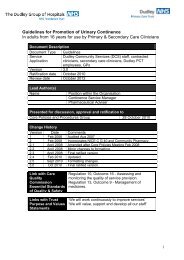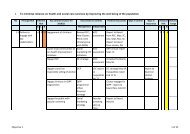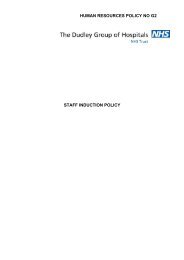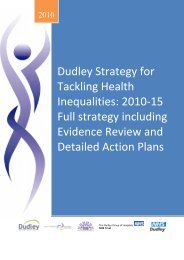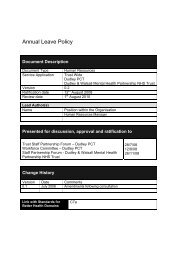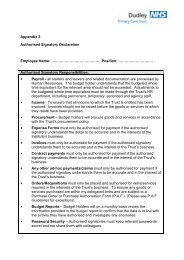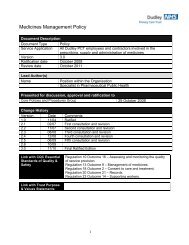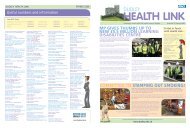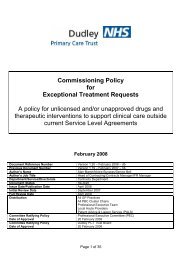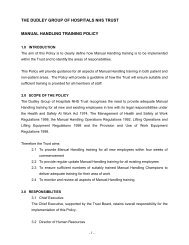Chronic Kidney Disease Pathway Document Description Presented ...
Chronic Kidney Disease Pathway Document Description Presented ...
Chronic Kidney Disease Pathway Document Description Presented ...
Create successful ePaper yourself
Turn your PDF publications into a flip-book with our unique Google optimized e-Paper software.
SUPPORTING INFORMATION:<br />
Introduction:<br />
Phosphate retention occurs in chronic kidney disease due to the reduction in the glomerular filtration rate. Hyperphosphataemia leads to a series of changes<br />
resulting in secondary hyperparathyroidism. This is a major concern because the high parathyroid hormone (PTH) levels play an important role in the<br />
development of renal osteodystrophy and considered as a “uraemic toxin” as well.<br />
From the viewpoint of calcium and phosphate balance, initially the hypersecretion of PTH may be appropriate. This would increase the calcium and phosphate<br />
release from bone and enhances urinary phosphate excretion as well. It can thus correct the hypocalcaemia and to some extent hyperphosphataemia. However,<br />
when the glomerular filtration rate (GFR) falls below 30 mls/min, this physiological change is no more maintained. At this stage, dietary phosphate restriction<br />
may still reduce the plasma phosphate and PTH levels to an extent but may not normalise the values. As a result, oral phosphate binders are more often<br />
required. This problem gets worse once the renal failure is advanced, especially in dialysis patients. In end stage renal disease (CHD 5), there is essentially no<br />
phosphate excretion by the kidneys and oral phosphate binders are a must to limit the dietary phosphate absorption.<br />
The combination of hyperphosphataemia and calcium product (determined by multiplying plasma, calcium and phosphate in mmol/L) when in excess of 4.4,<br />
there is a tendency for calcium to precipitate in soft tissues such as arteries, joints and viscera. This phenomena can lead to various vascular complications<br />
including coronary artery disease and peripheral vascular disease. Thus both morbidity and mortality rate increases with these advanced complications.<br />
Phosphate restriction: Restricting phosphate intake can be attempted with about 800 to 1000mgs per day (1)which some patients find acceptable. However,<br />
care must be exercised as limiting phosphate intake significantly can reduce protein intake resulting in malnutrition which can also increase the morbidity and<br />
mortality. A Specialist Renal Dietitian’s advice will be very useful in balancing such a diet. Most often in dialysis patients, we encourage them to avoid<br />
unnecessary dietary phosphate products such as colas, certain vegetables and excessive dairy products. At the same time, high biological value protein<br />
sources must also be increased to avoid malnutrition. Lengthening the dialysis or using larger and high efficiency dialysers may influence very marginally the<br />
phosphate removal. Many patients with chronic <strong>Kidney</strong> disease and all dialysis patients require the administration of oral phosphate binders to limit the<br />
absorption of dietary phosphate. Agents used to regulate phosphate balance include calcium salts and more recently Sevelamer and Lanthanum carbonate.<br />
Magnesium and Aluminium containing binders are now avoided because of safety concerns.<br />
Phosphate binders – bind phosphate in the gut and prevent its absorption. They must be taken with phosphate containing foods to be effective, they should<br />
not be taken at the same time as iron preparations and some antibiotics because together they form insoluble compounds in the gut – which reduces the<br />
efficacy of both drugs.<br />
There is some evidence that calcium containing phosphate binders are related to arterial/vascular calcification when compared to non-calcium containing<br />
binders. Hypocalcaemia can also cause soft tissue calcification.<br />
Produced by:<br />
Jane Elvidge, Senior Renal Pharmacist, RHH<br />
Clair Huckerby, Pharmaceutical Adviser, Dudley PCT<br />
Dr K A Shiva Kumar, Consultant Renal Physician, RHH<br />
Christine Morgan, Senior Specialist Renal Dietitian, RHH<br />
Alison Whitlock, Clinical Pharmacist<br />
Lucy White, Administration, Public Health Dept. Dudley PCT<br />
In consultation with:<br />
AMMC<br />
Renal LIT<br />
References:<br />
1. Renal Association Guidelines for the treatment of adult patients with renal failure; 4th Edition.<br />
2. National <strong>Kidney</strong> Foundation. K/DOQI clinical practice guidelines for bone metabolism and disease in chronic kidney disease. AM J <strong>Kidney</strong> Dis 2003;<br />
42(Suppl 3): S1-S202.<br />
3. Summary of product characteristics for Sevelamer (Renagel).<br />
4. Block GA, Hulbert-Shearon TE, Levin NW, Port FK. Association of serum phosphorus and calcium x phosphate product with mortality risk in chronic<br />
haemodialysis patients: a national study. AM J <strong>Kidney</strong> Dis 1998; 31: 607-617.<br />
5. Goodman WG, Goldin J, Kuizon BD et al. Coronary-artery calcification in young adults with end stage renal disease who are undergoing dialysis. N<br />
Engl J Med 2000; 342: 1478-1483.<br />
6. Guerin AP, London GM, Marchais SJ, Metivier F. Arterial stiffening and vascular calcifications in end stage renal disease. Nephrol Dial Transplant<br />
2000; 15: 1014-1021.<br />
7. Hutchison A, Webster I. Lanthanum carbonate, a novel, non-aluminium, non-calcium phosphate binder, is effective and well tolerated in<br />
hyperphosphataemia. Poster presented at the 9 th Asian Pacific Congress of Nephrology, 16-20 February 2003, Pattaya, Thailand.<br />
8. Wilson J. ARIF request on the risk of cardiovascular problems in patients using calcium versus metal- free (non- calcium) phosphate binders to treat<br />
hyperphosphataemia. ARIF. University of Birmingham.<br />
64




